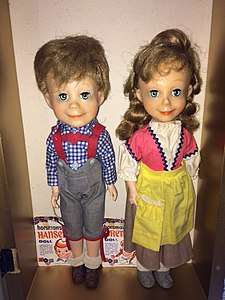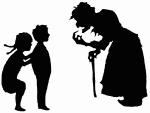Hansel and Gretel: An Opera Fantasy
Hansel and Gretel is a 1954 stop motion animated theatrical feature film released by RKO Pictures.
| Hansel and Gretel | |
|---|---|
| Directed by | John Paul |
| Produced by | Michael Myerberg |
| Written by | Padraic Colum |
| Starring |
|
| Music by | Franz Allers |
| Cinematography | Martin Munkacsi |
| Edited by | James F. Barclay |
| Distributed by | RKO Radio Pictures |
Release date |
|
Running time | 72 minutes |
| Country | United States |
| Language | English |
History
The film is based on Engelbert Humperdinck's opera Hänsel und Gretel, and incorporates music and songs from the opera. It was the first American feature-length animated film not made by Disney since 1941's Mr. Bug Goes to Town and the first American feature-length animated film not made with traditional animation.
It was released on October 10, 1954 in New York City without a distributor. Producer Michael Myerberg released the film himself.[1] Based on the positive reviews and box office performance, RKO Radio Pictures acquired the film for wide release for the Christmas season.[2]
The film was sold to television four years after it was released, where it became a Christmas season tradition on several affiliate stations.
In 1959, at the second annual Grammy Awards, conductor Franz Allers was nominated for the soundtrack in the category of "Best Recording for Children".[3]
The film was re-released theatrically in 1965 through New Trends Associates,[2] and in March 1973 through Metro-Goldwyn-Mayer.[4] The title was modified to "Hansel and Gretel: An Opera Fantasy" beginning with the 2001 DVD release.
Production
In 1952, Evalds Dajevskis began working for Myerberg Productions' to conceptualize the look of the film and design the miniature sets.[5] Dajevskis built the sets out of thick paper mache, appliqued paper cutouts, and painted backings. The Witch's Gingerbread House, the Hall of the Angels, and Hansel and Gretel's home were all constructed with trap doors underneath. Since the sets were so large, there was no way to get in and animate the figures except from below.[6]
The film was shot in Myerberg's Second Avenue Studios (located at 216 East 2nd St., between Avenue B and Avenue C).[7] The puppets used in the film were called "kinemins".[8] [9] The bodies of the kinemins were sculpted in clay by James Summers and cast in foam latex by George Butler. Summers also did the paint job and their "makeup.[6] The puppets were one-third life-size and cost $2,500 apiece to build.[10]
The Witch was re-named Rosina Rubylips. This is different from the original opera, where the witch tells Hansel that her name is Rosine Leckermaul (translated as Rosina Tastymuzzle).[11]
The mother and father figures were sculpted to resemble Mildred Dunnock (Death of a Salesman) and Frank Rogier, who supplied their voices.[6]
After production, the Hansel & Gretel sets were cut up, carted away, and eventually sold to an amusement park where they were poorly reconstructed in a tent for display. In 1955, vandals looted Myerberg's East Second Street studio and destroyed the remaining kinemins.[6]
In 1965, screenwriter Padraic Colum sold his copy of the screenplay (along with his notebooks, manuscripts, galley proofs, and letters) to the Binghamton University Libraries.[12] Within the collection, the screenplay is identified as: Box 18, Folder 10: Play Manuscript 21 and is available for research viewing.[13]
In 1971, producer Michael Myerberg placed "The Michael Myerberg Papers, 1940-1971" with University of Wisconsin–Madison Library.[14] "Hansel and Gretel" is among the productions documented through correspondence, contracts, financial records, promotional materials, reviews, and scripts.[15]
Vocal cast
- Anna Russell as Rosina Rubylips, the Witch
- Mildred Dunnock as Mother
- Frank Rogier as Father
- Constance Brigham as Hansel and Gretel
- Helen Boatwright as Dew Fairy
- Delbert Anderson as Sandman
- Apollo Boys’ Choir as Angels and Children
Awards and nominations
- 1954 Parents' Magazine Medal for Movie of the Month (October)[16]
- 1959 Grammy Award nominee for "Best Recording for Children"[3]
- 1995 Dove Foundation Family Approved Seal[17]
Merchandise
RKO heavily promoted the film in time for the 1954 Christmas season. There was $10 million worth of tie-ins, including candy, clothing, figurines and toys.[18]
 Salt and Pepper shakers
Salt and Pepper shakers Soap Set
Soap Set Figurines
Figurines 15" tall vinyl Dolls by Horsman[19]
15" tall vinyl Dolls by Horsman[19]
Home video and other media
The film has been released on VHS, CED videodisc, and DVD. The VHS and CED videodiscs contain the original title. The DVD was released on October 30, 2001[20] with the modified title of "Hansel and Gretel: An Opera Fantasy".
An LP of the film's soundtrack was released in 1955 under the label "X" RCA, in 1959 under the label RCA Victor, and in 1960 under the label RCA Camden.[21] In 1959, it was nominated for a Grammy Award in the category "Best Recording for Children".[3]
 DVD
DVD
References
- Priebe, Kenneth A. (January 1, 2011). The Advanced Art of Stop-Motion Animation. Cengage Learning. ISBN 1435457048.
- Beck, Jerry (October 28, 2005). The Animated Movie Guide. Chicago Review Press. ISBN 9781569762226.
- "Grammy Award Nominees 1959 - Grammy Award Winners 1959". www.awardsandshows.com. Retrieved April 14, 2018.
- "Banner Graphic 14 March 1973 — Hoosier State Chronicles: Indiana's Digital Historic Newspaper Program". newspapers.library.in.gov. Retrieved April 14, 2018.
- "Stop 24". The Art of Evalds Dajevskis. Retrieved April 14, 2018.
- Starlog Press (April 14, 1984). "CineMagic Issue #28". Retrieved April 14, 2018 – via Internet Archive.
- "Archival Resources in Wisconsin: Descriptive Finding Aids". digicoll.library.wisc.edu. Retrieved April 14, 2018.
- AFI|Catalog - Hansel and Gretel
- "Movie Review - - The Screen in Review; At Broadway: Puppets in 'Hansel and Gretel' - NYTimes.com". www.nytimes.com. Retrieved February 3, 2017.
- Inc, Nielsen Business Media (November 28, 1953). "Billboard". Nielsen Business Media, Inc. Retrieved April 14, 2018 – via Google Books.
- Desk, BWW News. "The Bronx Opera Presents HANSEL & GRETEL". Retrieved April 14, 2018.
- "Archived copy". Archived from the original on March 9, 2017. Retrieved September 20, 2018.CS1 maint: archived copy as title (link)
- "Archival Resources in Wisconsin: Descriptive Finding Aids". digicoll.library.wisc.edu. Retrieved April 14, 2018.
- "Archival Resources in Wisconsin: Descriptive Finding Aids". digicoll.library.wisc.edu. Retrieved April 14, 2018.
- "Motion Picture Daily (Oct-Dec 1954)". Quigley Publishing Company, inc. October 1, 1954. Retrieved April 14, 2018 – via Internet Archive.
- "Hansel And Gretel And Opera Fantasy - Dove Family Friendly Movie Reviews". Retrieved April 14, 2018.
- Beck, Jerry (October 28, 2005). The Animated Movie Guide. Chicago Review Press. p. 103. Retrieved April 14, 2018 – via Internet Archive.
- Herlocher, Dawn (May 29, 2005). "200 Years of Dolls: Identification and Price Guide". Krause Publications. Retrieved April 14, 2018 – via Google Books.
- "Hansel & Gretel: An Opera Fantasy DVD Movie". www.cduniverse.com. Retrieved April 14, 2018.
- "Hansel and Gretel - 1954 Soundtrack". Retrieved April 14, 2018.
External links
| Wikimedia Commons has media related to Hansel and Gretel: An Opera Fantasy. |
